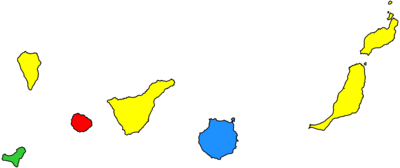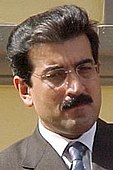Canarian regional election, 1999
|
|
|||||||||||||||||||||||||||||||||||||||||
|---|---|---|---|---|---|---|---|---|---|---|---|---|---|---|---|---|---|---|---|---|---|---|---|---|---|---|---|---|---|---|---|---|---|---|---|---|---|---|---|---|---|
|
|||||||||||||||||||||||||||||||||||||||||
|
All 60 seats in the Parliament of the Canary Islands 31 seats needed for a majority |
|||||||||||||||||||||||||||||||||||||||||
| Registered | 1,331,110 |
||||||||||||||||||||||||||||||||||||||||
| Turnout | 835,181 (62.7%) |
||||||||||||||||||||||||||||||||||||||||
|
|||||||||||||||||||||||||||||||||||||||||

|
|||||||||||||||||||||||||||||||||||||||||
|
|||||||||||||||||||||||||||||||||||||||||
The 1999 Canarian regional election was held on Sunday, 13 June 1999, to elect the 5th Parliament of the Autonomous Community of the Canary Islands. All 60 seats in the Parliament were up for election. The election was held simultaneously with regional elections in twelve other autonomous communities and local elections all throughout Spain, as well as the 1999 European Parliament election.
The Parliament of the Canary Islands was the devolved, unicameral legislature of the autonomous community of the Canary Islands, having legislative power in regional matters as defined by the Spanish Constitution and the Canarian Statute of Autonomy, as well as the ability to grant or revoke confidence from a President of the Government. Voting for the Parliament was on the basis of universal suffrage, with all nationals over eighteen, registered in the Canary Islands and in full enjoyment of all political rights, entitled to vote.
The 60 members of the Parliament of the Canary Islands were elected using the D'Hondt method and a closed list proportional representation, with a threshold of 30 per 100 of valid votes—which included blank ballots—being applied in each constituency. Parties not reaching the threshold were not taken into consideration for seat distribution. Alternatively, parties could also enter the seat distribution as long as they reached 6 per 100 regionally. Seats were allocated to constituencies, corresponding to the islands of El Hierro, Fuerteventura, Gran Canaria, La Gomera, La Palma, Lanzarote and Tenerife. Each constituency was allocated a fixed number of seats: 3 for El Hierro, 7 for Fuerteventura, 15 for Gran Canaria, 4 for La Gomera, 8 for La Palma, 8 for Lanzarote and 15 for Tenerife.
...
Wikipedia


